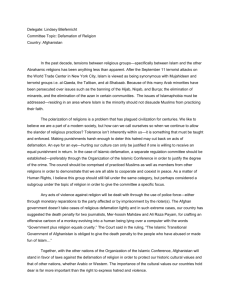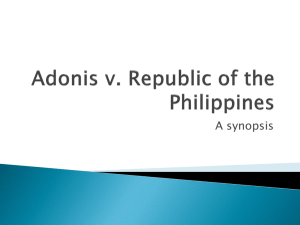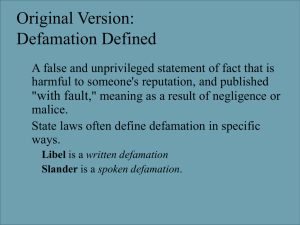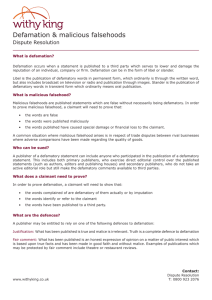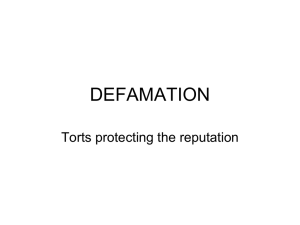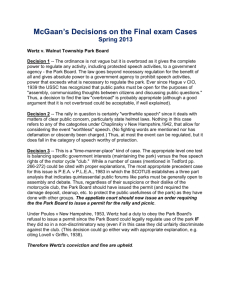in what ways is the law of defamation in need of reform?
advertisement
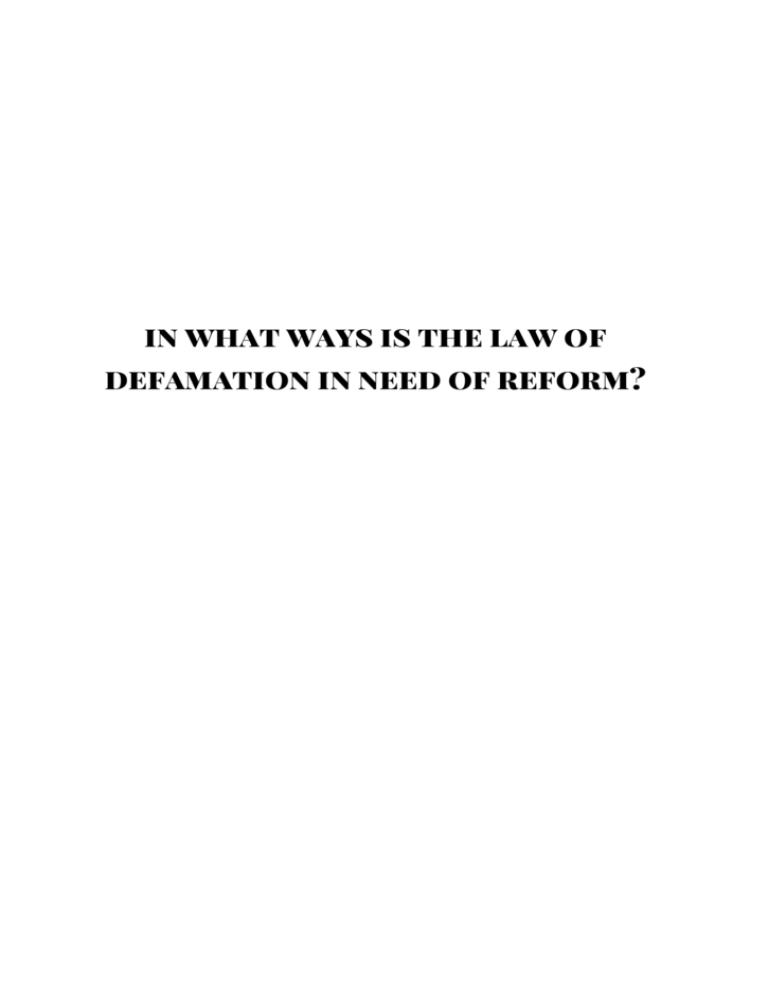
in what ways is the law of defamation in need of reform? The law of defamation will need reform where it contradicts the principles that underpin tort as a whole. Tort strives to: 1. Assert “corrective justice” with the aim of restoring the victim’s position to that as if no wrong had been committed;1 2. Deter those who otherwise may be tempted into wrongful conduct; 3. Provide a mechanism for affected parties/relatives to clarify obscure situations. Financial damages provided by the defendant (or his insurance) to the claimant are a practical and efficient compensation mechanism calculated to offset losses materialising from the wrong. Doctrines of strict liability prevalent within tort indicate that allocation of blame is not an end in itself, at least from the courts’ perspective. Though “many accidents occur… where no one is to blame”,2 the inevitable consequence of compensating perpetually smaller losses sought through imputing to a defendant has arguably resulted in a compensation culture of blame-­‐throwing, regrettable since increased availability of tort claims results in discouragement of personal responsibility.3 Though this decline is debatable, current fear of being sued undeniably results in caution in ventures which bring benefits to society. Such “over-­‐deterrence”4 is especially unpalatable considering legitimate deterrence is regularly undermined by the realities of insurance. Hence defamation should restore the claimant’s position when his reputation is unjustifiably attacked, having regard to: pecuniary losses like lost job prospects; non-­‐pecuniary personal hurt suffered; and preventing further damage by granting injunctions against re-­‐publication. Yet the law should not encourage extreme sensitivity to innocent/inoffensive remarks, the defamation equivalent of decreased personal responsibility. Furthermore, freedom of expression is indispensibly beneficial to society – the Human Rights Act prescribes “particular regard to… freedom of expression”,5 considered the “lifeblood of democracy”6 crucial for assessing fair governance. Chilling of such a democratically fundamental value is unacceptable: expression should be presumed of societal benefit and only rebutted when the specific circumstances directly prove the contrary to be true. Ergo in protecting reputations a metaphorical axe dividing defamation and expressive freedom is inappropriate; instead a surgical scapel should be precisely, prudently and flexibly applied by a fully aware judiciary. Protecting reputations is defamation’s acknowledged aim, yet its out-­‐dated historical derivations mean it draws unjustifiable assumptions of how the defamatory method affects reputation, as recognised by the Faulks Committee.7 The premise that transient slanderous remarks are less injurous than permanent libels may be an efficient way of pigeon-­‐holing cases, but is unjust since feasibly a libel in a publication known for poor reporting and exaggerative, unreliable statements may do little damage, and possibly even attract sympathy, whereas slander to one’s bosses or to peers could be highly damaging.8 Damages are recoverable in both, but the majority of slanders (discounting four awkward common law exceptions) require consequential losses resulting from the defamation to be proven to the civil standard – which can be an unreasonably hefty burden on claimants since they must “fairly and reasonably have been anticipated and feared”,9 so easily fail for remoteness. Such differentiation smacks of the axe rather than scalpel. Proof of the common law attachment to the concept, even when its application is utterly subjective, can be seen in cases Weinrib, 1995, 126 Transcript: Woodroffe-­‐Hedley v Cuthbertson (20/06/1997) QB 3 Morgan, 2004, 385 4 Horsey, 2009, 15 5 s12(4) 6 R v Home Secretary ex.p. Simms [2000] 2 AC 115; 126 7 Report of the Committee on Defamation (Cmnd 5909, 1975) 8 n4(above), 413 9 Lynch v Knight (1861) 9 HL.Cas. 577 1 2 of online defamation such as Smith v ADFVN where postings on a website’s bulletin board were paralleled with slanderous “casual conversation” despite being available for repeat viewing and easily re-­‐published online.10 Clearly black-­‐and-­‐white distinctions are inappropriate – their foundations seem weak and beg questions of classification particularly regarding modern technologies. There exist better measures reinforcing the floodgates against opportunistic claims and preventing imposing onerous burdens of self-­‐scrutiny on ordinary people than the unfair slander-­‐libel distinction and special damage slander requirement. Jameel v Dow Jones decided that a claim could only sound from a “real and substantial tort”, thus allowing swift rejection of the trivial.11 Sim v Stretch12 has been cited in Thornton v Telegraph Media Group as authority for the existence of a “threshold of seriousness” before a claim is deemed defamatory.13 Statutory increase in screening is currently proposed in the Draft Defamation Bill14 through requiring claimants to prove substantial harm, which would render the slander-­‐ libel distinction further redundant. Unfortunately, the draft bill does not remove it. Furthermore defamation claims are intransmissable upon either the claimant’s or defendant’s death, debatably denying broad corrective justice. Consequences of defamation may reduce family income/affect dependants yet the claim is attached to those directly involved. A scalpel approach would grant the opportunity for transmissability should the circumstances be deserving. In establishing defamation, the claimant must show that the statement was defamatory and published to a third party, that it referred to themselves and if applicable satisfies the requirement for special damages. Proving a statement is defamatory is a low hurdle: the leading test asks whether the conduct would “lower the plaintif in the estimation of right-­‐ thinking members of society”.15 Whilst this judicially-­‐constructed policy device allows them to avoid imposing problematic liability – opening the floodgates to trivia or onerously infringing freedom of speech – it contradicts alternative tests for defamatory statements: in Youssoupoff v MGM the different definition was “mak[ing] the Claimant be shunned and avoided… without any moral discredit on her part”.16 Tolley v Fry17 decided that how individuals generally (when possessing all information that may be required for legal/true innuendo), rather than a societal subsection, will perceive the statement is what matters; thus implying that the right-­‐thinking member operates underneath regardless of definition, entailing undesirable consequences: when somebody falsely labeled as a rape victim can sue for damages, it infers society is correctly prejudiced against rape victims. Moreover, such hypothetical personification of society is extremely distant from what claimants generally care about. Claimants, particularly non-­‐celebrities, are more bothered about how those they interact with perceive them, rather than indistinct, general ‘society’. For example where a trade union member is falsely accused of refusing to support an official strike this would likely be seen as disloyal amongst his colleagues and lead to being shunned, yet not be defamatory since right-­‐thinkers may applaud him for displaying “independence of thought”.18 The current law is in danger of not compensating all legitimate victims by being too strict with its right-­‐thinking criterion in a multi-­‐cultural, diverse society. As Keene LJ stated: [2008] EWHC 1797 (Transcript) [2005] Q.B. 946; 947 12 [1936] 52 TLR 669 (Westlaw:26/04/2011) 13 [2010] EWHC 1414 (Westlaw:26/04/2011) 14 clause 1 15 n12(above) 16 (1934) 50 TLR 581 (Westlaw:26/04/2011) 17 [1931] AC 333 18 obiter; Myroft v Sleight (1921) 37 TLR 646 (Westlaw:26/04/2011) 10 11 “The reputation of a person within his own racial/religious community may be damaged by a statement which would not be regarded as damaging by society at large.”19 A judge cannot possibly be representative of general values considering the variation in outlooks of individuals within society, meaning this supposedly objective test becomes a façade behind which the judge’s own opinion is advanced. Furthermore any general values rapidly change in a way the law can be slow to encompass due to precedent: calling someone ‘gay’ is no longer defamatory – unless the implication was that the victim was a liar, changing the focus – unlike Victorian attitudes.20 It is impractical to rely on individual judges being highly attuned to such change. Which judge analyses the defendant’s statement can inject significant luck into defamation outcomes, hence there exists a powerful argument for maintaing juries and even halting the current judicial scrutiny of whether a statement is defamatory in law. Yet the Senior Courts Act 1981, s69(1), conveys a discretion to exclude juries when the court deems their amateur status inconvenient for analysing professional documentation, like scientific studies. Whilst exclusion may have the advantage of reducing the costs of defamation claims – discussed later – it can result in hypocritical trials, like Steel v McDonald’s (‘McLibel’) where the amateur defendants were representing themselves without legal or scientific/technical counsel due to their ineligibility for legal aid and without a jury.21 This displays that judges can be overly sympathetic towards top barristers, and wrongly favour the powerful claimant when an imbalance in legal resources exists. Liberty organisation has noted this issue is “particularly important in defamation cases where… it is often the rich and powerful who seek to pursue critics through the courts”22 and that “jury trial offers the best model for the separate determination of matters of law and matters of fact… highly relevant in defamation cases.”23 The proposals in the Draft Defamation Bill to further reduce juries is worrying since they are theoretically better placed than judges to determine when corrective justice is merited and prescribe societal standards of compensation. Yet as Lord Bingham noted in John v MGN “juries [have] lacked an instinctive sense of where to pitch their awards,”24 resulting in severe penalisation of defamatory statements, especially by the press, instilling doubt in free expression and quelling willingness to publish controversial articles. However, this seems to be an argument for greater direction in awarding damages, rather than for complete exclusion, especially since jury trials may be the best way to prevent rich corporations inhibiting criticism of their business practices. Juries are unlikely to favour companies skating thin moral ice like McDonald’s. Reducing costs is crucial but blunt jury preclusion or the often proposed solution of a cheap libel tribunal process25 will undermine legitimacy. Palatable alternatives like promoting mediation; preventing celebrities/companies from suing over niceties; and increasing the damage threshold; do exist. The unpredictable consequences of legal action resulting from the difficulty in standardising reputation protection, further suggest that defamation requires increased direct societal input particularly in scrutinising the reasons behind a claim and the likelihood of the claimant receiving satisfaction. Claims have backfired to ruin reputations, like when Jason Donovan sued The Face and subsequently alienated many fans who wrongly assumed he was Transcript: Arab News v Jihad Al Khazen (02/02/2001) EWCA Civ n4(above), 418 21 http://www.mcspotlight.org/case/trial/story.html 22 Liberty’s Second Reading Briefing: Defamation Bill, HL, July 2010, p16 http://www.liberty-­‐human-­‐rights.org.uk/pdfs/policy10/liberty-­‐s-­‐second-­‐reading-­‐briefing-­‐on-­‐lord-­‐lester-­‐s-­‐defamation-­‐bill.july-­‐2010.pdf 23 ibid 24 [1997] QB 586; 608 25 Mullis, 2009, 9 19 20 homophobic.26 More sophistication in analysing whether suing is appropriate is required, yet reform proposals generally focus on the litigation. Defamation has been rightly criticised as belonging to the rich: the high costs of bringing a claim prevent those of normal means from protecting their reputations, especially as legal aid has historically been unavailable. The situation may have improved: the European Court in Steel v UK27 held that absence of aid in circumstances of gross imbalance – McDonald’s sued a gardener on £64/week28 – transcended the right to fair trial. Presumably, the Lord Chancellor must now allocate aid (using s6(8) Access to Justice Act 1999) in unbalanced cases, since the HRA requires European Court decisions to be “take[n] into account”29 to ensure legislative compatibility with the ECHR. However the degree of imbalance required domestically is uncertain. Furthermore, the private sector has adopted a “no-­‐win, no-­‐fee” incentive where the legal professionals undertake the claimant’s risk. Yet since the costs recovered from the other side are inflated to include ‘success fees’ for commercial viability, the burden on the defendant is increased.30 Such awards have been sanctioned by the highest court in Campbell v MGN (No.2),31 though in this case the wealthy Mirror Group was defending, the ordinary citizen with less deep pockets could be deterred from free speech. Further evidence of charging the defendant beyond corrective justice arises from exemplary damages, imposed when the defamer intended to gain “mercenary advantage” and lacked an honest belief in his statement’s truth, had refrained from taking obvious verifying steps, and the compensation alone is insufficient as a punishment/deterrent.32 Whilst effective deterrence is an aspiration of tort, the value levied is wildly subjective as John shows – the Court of Appeal invoked the Courts and Legal Services Act 199033 to reduce exemplary damages by 82%!34 Furthermore, the European Court has criticised UK law for not providing adequate safeguards against large awards “[un]necessary in democratic society”.35 The protection offered by the European Court to McLibel-­‐esque defendants is only accessible by those brave enough to shoulder the additional risk of losing and paying costs in Strasbourg. A margin of appreciation is extended enabling domestic government to balance the viability of corporations – by choosing a mechanism for companies to defend against false attacks on their reputations – and the public interest in facilitating criticism of amoral business practices. Proponents of free speech with justifiably little confidence in the current law to fairly balance these concerns urge that defamation claims should be prohibited for companies, extending the line drawn for executive bodies (Derbyshire County Council v Times)36 and political parties (Goldsmith v Bhoyrul).37 There still exists the tort of malicious falsehood which could protect companies – and therefore their employees/shareholders – from the worst statements, and, unlike individuals, corporations are unlikely to be affected by the smaller damages awarded. Furthermore companies generally have sizeable advertising budgets to offset any reputation damage. Though fledgling enterprises may need some support/exemption, the advantage of preventing unscrupulous businessmen like Robert Maxwell38 from using defamation law to foil exposures of amoral conduct seems worthwhile. The most common defendants are the media groups, however, who play a fundamental devil’s advocate role within our democracy. Tort law should encourage them to be responsible in this http://www.guardian.co.uk/music/2007/oct/04/popandrock1 [2005] EMLR 15 (68416/01) (Westlaw:26/04/2011) 28 http://www.mcspotlight.org/people/biogs/steel.html 29 s2(1) 30 n25(above), 11 31 [2005] UKHL 61 32 n27(above) 33 s(8) 34 n27(above) 35 Tolstoy v UK (1995) 20 EHRR 442 36 [1993] AC 534 37 [1997] QB 459 38 http://news.bbc.co.uk/1/hi/business/1249739.stm 26 27 task, which the Faulks Committee concluded meant being factually accurate, hence justifying strict liability.39 Yet there exist persuasive arguments that such strictness is unreasonable when the defamation is accidental or unfortunate. The common law position dictated by Hulton v Jones,40 applied in Newstead v London Express,41 imposes liability when reasonable people would relate the statement to the claimant regardless of who the intended target was, since they were distinguished insufficiently. The tenability of this logic has been indirectly questioned by O’Shea v MGN where a similar claim instead involving defamation by photograph failed since requiring publishers to verify/distinguish every picture printed would be an “impossible burden” to bear and would transcend Article 10.42 Moreover it would be a sign of an unpalatably litigious culture analogous to the compensation culture unwanted elsewhere in tort. Morland J recognised that without the HRA, he would have been forced to extend Hulton strict liability to photographs, “notwithstanding the novelty of the facts”.43 Both situations could be resolved with additional accompanying detail suggesting either Hulton is incompatible with the ECHR, or Moulton J was wrong in denying a remedy for defamed look-­‐alikes as an unnecessary transgression of free speech in democratic society. This inconsistency hints that defamation’s principles are unclear within the current rights-­‐based constitution. Lest it be inferred from Hulton that the House of Lords regards reputations as more sacrosanct than freedom of speech, they have fairly explicitly rebutted this by widening the qualified privilege defence for the media in Reynolds v Times Newspapers where providing that Lord Nicholls’ non-­‐exhaustive criteria for responsible journalism are satisfied, defamation claims can be nullified if the published information can be interpreted, using a broad definition, as within the public interest, even if untrue.44 This lifeline grants editorial confidence in being controversial, especially since Jameel v Wall Street Journal45 recently criticised the lower courts as not allowing the defence often enough. Defences within defamation play a weighty role in redressing a claimant bias established by initial presumptions. Any defendant who can prove their statements’ truth rebuts the falseness presumption since the courts will not protect undeserved reputations. Honest belief is insufficient meaning flippant, common-­‐sensical remarks can be awkward to prove and even lead to claimants gambling that the defendant will be unable to prove true statements46 – enabling acquisition of undeserved reputations! Furthermore, the initial false onus prevents defamation being a clear route to vindication – courts cannot describe statements as actively false – hence how effective successful claims are at protecting reputations is questionable; undermining the third tortious principle of this essay’s introduction. Further issues arise from the fair comment defence where genuine, unmalicious opinions on matters of public interest (arguable in itself) based upon true facts are not liable; to protect those with prejudiced/strong opinions from being silenced, and enable forceful criticism without fear. Yet as Convery v Irish News displays the distinction between opinion versus factual statement is murky, especially considering subjective facts like the wateriness of cola may not be ascertainable.47 Debatably fair comment offers little additional protection of free expression than justification, since it can be awkward to prove subjective facts – increasingly so as juries are excluded. The concessions to potential defendants arising from Kemsley v Foot48 which removes any requirement to explicitly state the grounding facts when opining n7(above) [1910] AC 20 41 [1940] 1 KB 377 42 [2001] EMLR 40 (Westlaw:26/04/2011) 43 ibid 44 [2001] 2 AC 127 45 [2006] 2 AC 465 46 n4(above), 429 47 [2008] NICA 14 48 [1952] AC 345 39 40 and by s6 Defamation Act 1952 which enables successful claims when only some grounding facts are proven do not attack the root issues however right it may be that opinions should not be founded on fabricated facts. Both absolute and qualified privilege grant defamatory “immunity”,49 recognising the need for unhindered free speech in certain circumstances. Yet negligence has recently been allowed to subvert this protection in Spring v Guardian Assurance,50 without requiring proof of malice, by imposing a duty of care on referees “not to cause economic loss by writing untrue defamatory words.”51 Such lip-­‐service impunity suggests the correct boundaries of free expression are unknown – implying the law is lost. How far this extension infringes other qualified relationships – where both statement maker and receiver have a legal, social or moral duty in the communication52 – is currently unknown. Furthermore, it is a small step from this decision to extending negligence to impose a duty not to defame, potentially extinguishing current defamation and enabling the malleable principle of negligence “culpa” to address its inherent problems.53 Defamation needs significant reform. Historically derived concepts like the right-­‐thinking person test, slander-­‐libel distinction, etc should be dismissed as primitively black-­‐and-­‐white, unsuccessful at establishing societally-­‐approved corrective justice. Defamation is a poor deterrent since it is biased towards the resourceful and manipulable for unethical ends; drawing stark contrast with emerged human rights principles. Freedom of expression though difficult to outline and tricky to balance against reputations is ineptly guarded as evidenced throughout defamation’s foundations, especially in the hypocritical exceptions/prerequesites surrounding defences and initial claimant-­‐friendly presumptions. Reducing direct societal input through jury exclusion compounds these problems but extension of negligence may offer the opportunity for a fresh start. Rogers, 2006, 561 [1995] 2 AC 296 51 Descheemaeker, 2009, 636 52 Adam v Ward [1917] AC 309 53 n54(above) 49 50 Bibliography Collins, M (2006): “The Law of Defamation and the Internet”; Entertainment Law Review; Vol.17; Iss.6; p186 Descheemaeker, E (2009): “Protecting Reputation: Defamation and Negligence”; Oxford Journal of Legal Studies; Vol. 29; Iss. 4 – Winter; p603 Faulks Committee: Report of the Committee on Defamation (Cmnd 5909 of 1975) Horsey, K; Rackley, E (2009): “Tort Law”; Oxford University Press; 1st Edition Liberty’s Second Reading Briefing: Defamation Bill in the House of Lords, July 2010 http://www.liberty-­‐human-­‐rights.org.uk/pdfs/policy10/liberty-­‐s-­‐second-­‐reading-­‐briefing-­‐on-­‐lord-­‐lester-­‐s-­‐ defamation-­‐bill.july-­‐2010.pdf Last Checked 26th April 2011 Ministry of Justice: Draft Defamation Bill Consultation CP3/11 March 2011 Mullis, A; Scott, A (2009): “Something rotten in the state of English libel law? A rejoinder to the clamour for reform of defamation”; Communications Law; Vol. 14; Iss. 6; p173 Westlaw Last Checked 26th April 2011 Morgan, J (2004): “Tort, Insurance and Incoherence”; Modern Law Review; Vol. 67; Iss. 3; p384 O’Dell, E (2005): “Defamation reform in England and Ireland after McLibel”; Law Quarterly Review; Vol.121 (July); p 395 Rogers, W (2006): “Winfield and Jolowicz on Tort”; Sweet & Mawell; 17th Edition Weinrib, E (1995): “The Idea of Private Law”; Harvard University Press Websites: Last Checked – 26th April 2011 http://news.bbc.co.uk/1/hi/business/1249739.stm http://www.mcspotlight.org/ http://www.mcspotlight.org/case/trial/story.html http://www.mcspotlight.org/people/biogs/steel.html http://www.guardian.co.uk/music/2007/oct/04/popandrock1 Cases Adam v Ward [1917] AC 309 Arab News v Jihad Al Khazen (Transcript): 2nd February 2001 EWCA Civ Campbell v MGN Ltd [2005] UKHL 61 Convery v Irish News [2008] NICA 14 Derbyshire County Council v Times Newspapers [1993] AC 534 Goldsmith v Bhoyrul [1997] QB 459 Hulton v Jones [1910] AC 20 Jameel v Dow Jones [2005] QB 946 Jameel v Wall Street Journal [2006] 2 AC 465 John v MGN Ltd [1997] QB 586 Kemsley v Foot [1952] AC 345 Lynch v Knight (1861) 9 HL.Cas. 577 Myroft v Sleight (1921) 37 TLR 646 Newstead v London Express [1940] 1 KB 377 O’Shea v MGN Ltd [2001] EMLR 40 R v Secretary of State for Home Department ex parte Simms [2000] 2 AC 115 Reynolds v Times Newspapers [2001] 2 AC 127 Sim v Stretch [1936] 52 TLR 669 Smith v ADFVN plc [2008] EWHC 1797 Spring v Guardian Assurance [1995] 2 AC 296 Steel v UK [2005] EMLR 15 (68416/01) Thornton v Telegraph Media Group [2010] EWHC 1414 Tolley v Fry [1931] AC 333 Tolstoy v UK (1995) 20 EHRR 442 Woodroffe-­‐Hedley v Cuthbertson (Transcript): 20th June 1997 QB Youssoupoff v Metro-­‐Goldwyn-­‐Mayer Pictures Ltd (1934) 50 TLR 581
